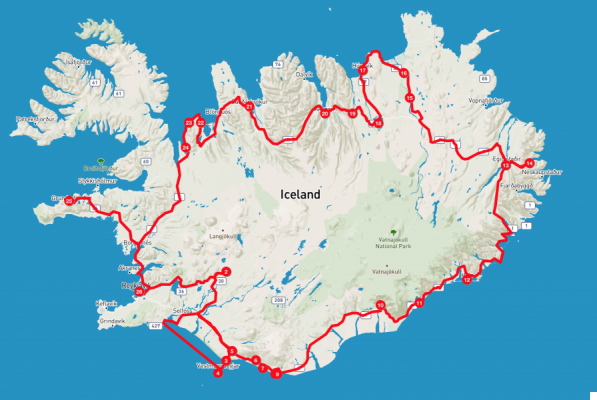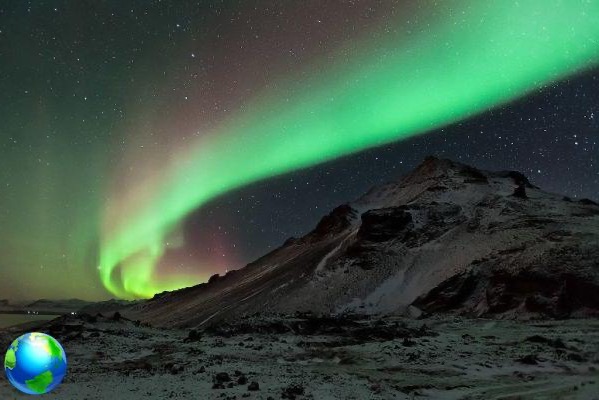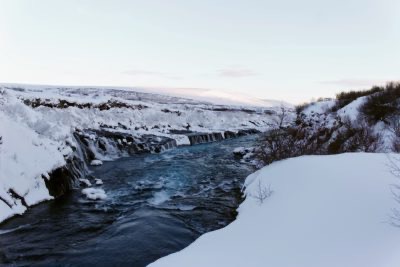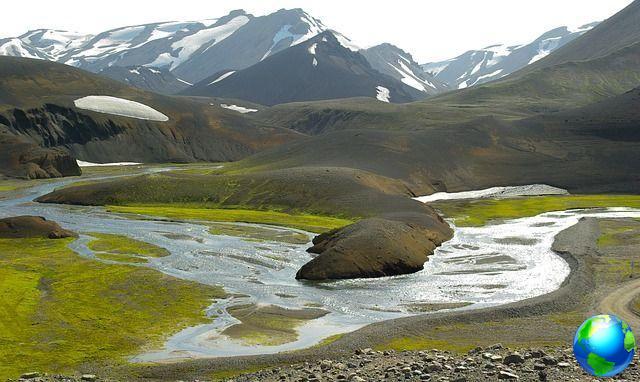After years of waiting, in 2019 I also finally visited Iceland! Hallelujah !! After the bankruptcy of 2008 the country has recovered and, from 2015/2016 onwards there has been a real tourist boom (also thanks to the lowering of the price of flights with the arrival of low cost). It goes without saying that it is a truly incredible country, full of water and natural resources, inhabited by less than 400.000 inhabitants. Iceland is a wild and unspoiled land as there are few left. If you intend to organize a trip to the country there are some things you should know first and you will find them all written in this article (at least I hope, otherwise tell me!) And in the articles Iceland: what to see in 10 days e Low cost Iceland: 10 ways to save.
How to get to Iceland
The most convenient way to reach Iceland is of course by plane. From spain there are several companies that fly on the one international Airport of the island which is located in Keflavik, about 50km south of Reykjavik. In summer (generally from June to September) they exist direct flights from Milan with Icelandair which take about 4h; during the rest of the year you will necessarily have to make a stopover in other European cities. In most cases in Copenhagen, London, Oslo or Frankfurt. As always, I recommend that you consider a stopover of at least 2 hours, to reduce the risk of your luggage remaining in the stopover airport. In the unfortunate event that your luggage does not arrive with you in Reykjavik… fear not! I was able to see all the efficiency of Iceland first hand! They will take care of carrying your luggage even in the middle of the fields, in every corner of the island, and they really do! There is also a sea connection between Denmark and Iceland but you will need to have a lot of time to spare.
How to get to the center of Reykjavik from Keflavik airport
The main options for getting to the center of Reykjavik are 2:
● Public bus of the Straeto which costs 1560 ISK (about 12 euros). You can pay directly on board, only by card. It takes 1 hour and 10 and arrives in the center.
● Flybus bus which costs 4999 ISK (36 euros) one way or 6999 ISK (50 euros) a / r, leaves every 25-30 minutes and takes you directly near your hotel (it makes several stops in the city). It takes about 45 minutes. When you buy the ticket they will give you a colored sheet because, halfway through the journey, you will then be sorted on smaller shuttles according to the area of the hotel. It can be booked online or taken locally. If you buy the one way only, the next day they send you a 10% discount for the return on your email. When you need to pick it up for the return, book it online because they will tell you what time to pick it up based on your flight. Buses are always there for all flights, even those that arrive at night.
 .jpg">
.jpg">When to go to Iceland for the Northern Lights (and the midnight sun)
Beyond what one might think, Iceland is never too cold, especially given its latitude. This is thanks to the Gulf Stream which touches the island on its southern and southwestern sides. In the north and in the center in the middle of winter it can reach -15 ° but in Reykjavik, for example, it rarely drops below zero. Unless you want to visit Iceland in the snow or the Northern Lights the best time to see the whole island is from May to September, with July and August which are the high season months where prices rise dramatically. If you want to enjoy the midnight Sun or the sun that never sets you will have to go in July. Personally I was there in mid-September and I was happy because the days were still long enough and I could see the Northern Lights twice! The problem with Iceland is that it is in an area of strong atmospheric thermal contrasts and the weather changes dramatically several times a day from the sun to violent hail. In the north there is often very strong wind (be careful when opening the car doors!). If you want to focus on the Northern Lights, the best months are from October to March / April. Visit the TimeAndDate site to know the sunrise and sunset times on a given day and on Aurora site for forecasts regarding the Northern Lights.
bus-or-car-">How to get around Iceland: bus or car?
bus
The cheapest way to get around Iceland is by bus. The network is very extensive and covers all tourist areas. There are 3 main companies: the Straeto (the public one), which operates all year round and has the largest network, the Sterna and SBA-Norouleid which operate at full capacity from May to mid-October (and only from the end of June to the end of August along the slopes inside). All places of tourist interest are covered, except the North-West fjords (where practically all roads are unpaved). If you are alone or in 2 the bus is really the best option to travel in Iceland, although you must consider that some locations (including the most popular ones) may be connected only once a day. Some companies sell a passport (a flat-rate ticket) which covers certain areas and is often cheaper than buying single tickets so ... ask first!
 .jpg">
.jpg">Rental car
If you are traveling at least in 3 or if you have no particular budget limits, there is no doubt that the rental car is the most comfortable way to explore Iceland, the one that guarantees you total freedom, as well as allowing you to shelter in case of bad weather (which is no small feat!). There Ring Road N.1 (the circular road that goes around the island) is almost completely asphalted, but the other roads are not, both those that cross the interior and those that reach the fjords. My advice is to orient yourself on a 4 × 4 car (possibly diesel to spend less on fuel), at least you will have no problem reaching some places that deviate a little from the Ring Road. Some roads (for example that of the Vatnsnes peninsula or those of the North-West fjords) are really ugly and full of holes and even with the 4 × 4 you have to go at 10 km / h! And if you go there in winter the 4 × 4 is really mandatory. The cost of a 4 × 4 car varies between 50 and 100 euros (or more) per day depending on whether it is low or high season (July and August); to these figures you will have to add the supplementary insurance and any other items (eg second driver, etc.). If, on the other hand, you go there in the summer months, book your rental well in advance (even 2 months), otherwise you risk not finding any cars available. For car rental I normally use the search engine Rentalcars, but if you want to save you can find all the tips in the article Low cost Iceland: 10 tips to save.
The roads in Iceland
Ring Road N.1 tends to be paved, is in good condition, and can be traveled all year round (except during blizzards or other similar events). Many other roads or tracks (eg F-roads, mountain roads) are only practicable in the summer months and are closed in the other months. If you do not respect the closing signs and you find yourself having problems with the car you will not be covered by the insurance so .. ociooo! Remember to check (daily) the state of the roads on this site before planning any itinerary that goes off the Ring Road!!
Insurance, petrol and other tips
When renting a car, pay close attention to the type of insurance already included. Icelandic car rentals have coverage a little different from the "classic" ones; they do not cover, for example, damage from atmospheric agents (which are more than frequent given the climate) nor tires .. so inquire very well first and, if necessary, buy the KASCO or make additions to the basic insurance.
For the gas, you will always find gas stations along the Ring Road, even if in some points (eg in the north) there will not be many so, even in this case, avoid finding yourself with little fuel in those stretches. THE N1 distributors are the most widespread and it suits you buy now of prepaid cards N1 (they exist from 5000, 10.000 or 20.000 ISK - 36, 72, 145 euros) because they allow you to refuel at any time of the day (the hours of the shops are sometimes ridiculous!).
Pay attention to:
- speed limits (there are often radar positions for checks, especially in the south)
- signs of danger or road closures
- sheep! They have a habit of crossing the street just as cars go by!
- Parking: often they are paid but there are no bars. Read the signs carefully because there are still cameras and you could then get fines. The parking spaces are all paid for with credit cards.
 .jpg">
.jpg">Where to sleep in Iceland
A problem that Iceland has had to face in recent years is certainly that of accommodation. With the explosion of tourism, especially in the summer months, the island's population triples; the requests are many and the beds are never enough. If you go there in the summer months, book well in advance otherwise you will find yourself sleeping in the car if you don't have a tent !! The solutions for sleeping in Iceland are:
Campsites
The cheapest solution! In Iceland there are municipal or private campsites practically everywhere e one night costs from 1000 to 2000 ISK per person (7-14 euros). If you plan to camp a lot you can consider buying it Camping Card (159 euro - price 2020)
which can be used for 2 adults (and up to 4 children) and is valid for 28 days. With this card (which is a kind of prepaid card) you can camp freely in 38 partner campsites around Iceland. Campsites in Iceland are not reserved so you can go anywhere freely (hoping that everything is not full!). The card can be bought online and received at your home or you can buy it in different places directly on site. If you don't want to bring camping equipment from Spain (especially if you fly with a low cost company it can be impossible!) you can rent everything directly there through sites like this.
Cottage e Guest House
There are guest houses of all kinds and with different levels of comfort. On this search engine you can find the one that suits you best. The price usually starts from 100-150 euros per night.
Hostels
In Iceland there are several hostels and they can be an economical solution because they usually have a kitchen and you can prepare your own meals. this is the site of the Icelandic network of hostels affiliated with Hostelling International where you can see and book them (they are often also found on the Booking website). The price of a night in a dormitory usually starts at around 20 euros per person.
.
The standard of hotels in Iceland (apart from Reykjavik) is not particularly high. Hotels are usually very basic but functional (with some exceptions). The price of a double night room usually costs no less than 80-90 euros.
These are the places where I slept:
- Reykjavik: Luna Apartments - beautiful apartments of various sizes right in the city center.
- Isola di Vestmannaeyjar: Hotel Vestmannaeyjar the most beautiful hotel on the island, with excellent spa and bar / restaurant interiors
- Vik: Black Beach Suites very nice apartments overlooking the coast and the sea
- Hofn: Fosshótel Vatnajökull - very nice hotel just outside Hofn, with beautiful mountain views
- Egilsstadir: The Guesthouse - Lake Hotel Egilsstadir - a beautiful renovated farmhouse next to the lake, excellent restaurant
- Husavik: Guesthouse Brekka - basic but nice apartments a few km outside Husavik
- Akureyri: Hotel Kjarnalundur - large and comfortable hotel a little outside the city, immersed in the woods
- Hvammstangi: Huts in Víðidalur - small wooden cottages (with external bathroom) immersed in the woods
 .jpg">
.jpg">How much does a trip to Iceland cost and how to pay (all with a credit card!)
If I have to find a negative note to this wonderful country at all costs, it is certainly its cost of living: Iceland is dear with fire!!! Among the countries I have visited so far it is the most expensive, on a par with Norway. However, there are several ways to save, even a lot: you can find everything in the article Low cost Iceland: 10 ways to save.
Regarding currency and payments, in Iceland the Icelandic Krona (ISK) is used and you pay EVERYTHING (absolutely EVERYTHING) with your credit card. I think it is the only trip in my life in which I have never exchanged or withdrawn in local currency. To make you understand, even the public toilets (which cost 1 euro typical) can be paid for by card. It is therefore a super digitized country you will never need cash (maybe 2 cards but yes, in case one does not work!). If this makes you anxious, you will find an exchange office at Keflavik airport and some in downtown Reykjavik and cash machines (ATMs) more or less everywhere (microscopic countries, gas stations, supermarkets, etc.).
What to bring to Iceland
Considering the climate and the fact that in Iceland it often rains and 'windy', in addition to the classic things (gloves, scarf, windbreaker, etc.) there are some things that you absolutely must take with you to avoid getting wet or getting your luggage or your photo / video equipment type:
- Waterproof pants in Gore-Tex
- technical thermal shirts
- Sampei-style raincoat
- scarponcino in Gore-Tex
- backpack cover
- waterproof shoe covers
- waterproof case for the camera
 .jpg">
.jpg">Health insurance is recommended
Being in Europe, as Spanish citizens we have the right to health care, but there are specific conditions and ceilings. My advice is to still take a classic medical-luggage insurance that can cover you during the trip, even for Covid-19. I am very happy with many insurance companies, a site that compares the policies of different companies and proposes the most convenient policy for that particular trip. To do this you will have to enter the data relating to your trip and they will send you an email with the best proposal that you can then buy directly online (!!!). All travel insurances also cover medical assistance in the event of a coronavirus infection, including testing if necessary. There is also coverage for the extension of the stay in the hotel due to the quarantine. Likewise, the trip cancellation guarantee includes coverage for illness or death of the traveler or a family member due to COVID-19.








